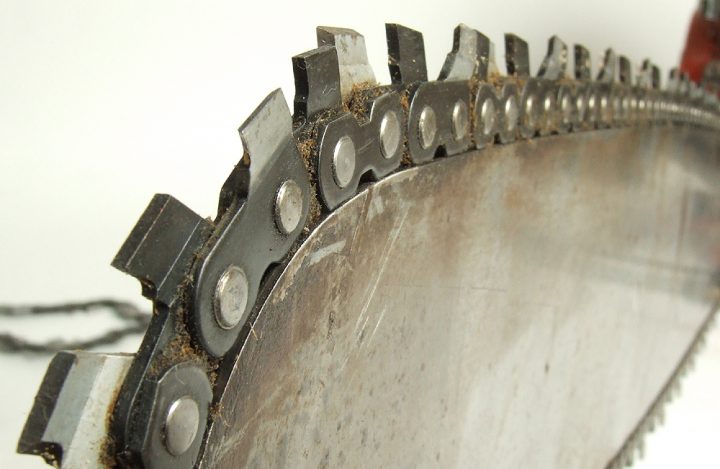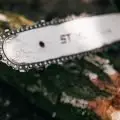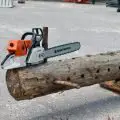Are you attempting to use your chainsaw to make a longer cut? Or are you merely considering a replacement bar? There’s a lot to consider before you go ahead and put a longer bar on your chainsaw.
In this article, we’ll answer can you put a bigger bar on a chainsaw, the potential benefits and drawbacks of doing so, and how to!
Table of Contents
- Can You Put a Bigger Bar on a Chainsaw?
- What Are the Benefits of Putting a Longer Bar on a Chainsaw?
- What Are the Drawbacks of Putting a Longer Bar on a Chainsaw?
- Key Takeaway
- Additional Components
- How to Put a Longer Bar on Your Chainsaw
- FAQs (Frequently Asked Questions)

Can You Put a Bigger Bar on a Chainsaw?
Both yes and no is the answer. On your chainsaw, you may add a longer bar, but not just any longer bar. To function successfully, the new ones must comply with the saw’s specifications, which include:
- Engine size
- Bar size
- Chain size
- Sprocket
The following order can be used to verify these requirements:
- Compatibility of the engine with bar length.
- Compatibility of chain with the new bar.
- Compatibility of the sprocket with the chain.
For particular length bars, chainsaws must have enough power. The saw won’t cut correctly if this isn’t done since it won’t have enough power. When determining whether you can attach a long bar to your chainsaw, there are two key ways of checking if it’s possible:
- Chainsaw engine power
- The manufacturer’s manual
1. Chainsaw Engine Power: Bar Length to Engine Size
Chainsaws need a given amount of power to run a specific bar length, which varies according to the power source. The saw won’t work without it. A chainsaw can often handle a longer guide bar the more powerful it is. A chainsaw’s power is expressed in the following units depending on its power source:
- Gas-powered chainsaws: CC (Cubic Centimeter)
- Battery-powered chainsaws: Volts
- Electric chainsaws: Amps
This power-to-bar compatibility table is not particular to any chainsaw brands or models; rather, it serves as a general guideline. Check the user manual (guidance to follow) for your particular model for a precise solution.
Chainsaw Bar Length vs cc Chart
| Power Source | Engine Power Rating | Bar Length |
|---|---|---|
| Gas | 32cc – 42cc | 14 – 16 Inches |
| Gas | 45cc – 50cc | 18 – 20 Inches |
| Gas | 51cc – 60cc | 20 – 24 Inches |
| Electric | 8 – 12 Amps | 10 – 16 Inches |
| Electric | 13 – 15 Amps | 14 – 18 Inches |
| Battery | 18 – 24 Volts | 10 – 12 Inches |
| Battery | 36 – 40 Volts | 10 – 16 Inches |
| Battery | 54 – 60 Volts | 14 – 16 Inches |
| Battery | 56 – 80 Volts | 16 – 18 Inches |
2. Checking Your Chainsaw Manufacturer’s Manual
I realize how dull user instructions can be. Don’t worry; I have a method to locate and automatically search chainsaw user manuals that should make the process quite simple for you.
The fact is that chainsaws are dangerous tools to use. Therefore, it’s crucial to use components that fit well and to pay attention to the details to ensure your safety.
You may get a good idea of the range by using the table of appropriate bar lengths above. The manufacturer’s manual is ultimately the best resource for finding out which bars can be used with your particular chainsaw. If you do not have the physical copy handy, follow this guidance:
1. Google “[Chainsaw Name] Users Manual”
For example, for a Husqvarna *model number* chainsaw, simply google “Husqvarna *model number users manual”. It’s more than likely going to be the #1 result on Google, which will take you directly to the Husqvarna chainsaw website.
2. Use “CTRL + F” (or “CMD + F” on Mac) to Search for Bar Length
Since you’re looking to see if you can run a longer chainsaw bar, hit the CTRL and F keys (or CMD F on Mac) on your keyboard at the same time which will bring up a search box. Here you can type in “bar length”.
3. Find the Different Recommended Chainsaw Bars
You can now navigate directly to the part of the user manual where your manufacturer describes the different recommended chainsaw bar lengths for your model.
What Are the Benefits of Putting a Longer Bar on a Chainsaw?
The obvious benefit of a longer bar is that, if the saw is powerful enough, it will allow you to cut through a piece of wood with a bigger diameter in a single pass due to its longer cuts.
What Are the Drawbacks of Putting a Longer Bar on a Chainsaw?
Another thing to keep in mind is that the cutting performance will decrease as the length of your chainsaw bar increases. Therefore, as you approach the top end of the bar range, you can anticipate a slightly lower cutting power from your chainsaw. The length of the cut and the force applied to the chain must be balanced.
Consider putting a 20-inch bar on a 50-CC gas chainsaw as an example. The 20-inch bar would certainly have a larger cut length than an 18-inch bar. The chain must move farther away from the engine, though. Running at 18 inches has a shorter stride but a stronger kick. You see what I mean.
Key Takeaway
Longer bars require more torque since the drag is much higher. If the saw is lean, you will create less torque than you would with a carburetor that is properly tuned for the length of the bar. Longer bars increase drag, which increases heat in the motor. When an engine is under more load it heats up, when an engine heats up it requires more fuel.
As a result, you must set the motor richer to compensate for the increased heat. Additionally, as a motor runs hotter, it becomes leaner, so you must set the carburetor richer to prevent lean burn. The engine will continue to heat up and increase in no-load rpm if you don’t give it more fuel until the piston begins to melt or something breaks.
Additional Components
You should also think about how changing your guide bar can affect other chainsaw parts before making the modification. A new guide bar specifically could imply that you additionally require the following other parts:
- New chain
- New sprocket
The length of the bar the saw can handle is determined by the engine, and a longer or smaller bar can only be used for as long as the engine is able to rotate the chain on that new bar. The original chain will probably not fit the new length with a longer bar. Therefore, you will also need to purchase a new chain.
The chain revolves around the bar thanks to the sprocket. The driver sprocket’s grooves must suit the chain’s driver links. The sprocket may need to be replaced as well in order to accommodate the chain due to the bar’s effect on the chain.
For optimum performance, each of these components must fit together correctly. If there is an incompatibility, the saw may be harmed or put the user in danger.
A piece of advice: every time you get a new guide bar, also purchase two chains and a new sprocket. Buying this group of parts together will make it easier for you to keep everything serviced because they will all wear out at the same time. Additionally, if you purchase them all at once, you can ensure compatibility.
How to Put a Longer Bar on Your Chainsaw
When changing the blade, it is essential to follow the right steps and take the necessary safety precautions to prevent harming internal components or endangering the operator’s safety. You can change to a longer bar using the instructions below as a guide.
Remove Old Bar
Remove the side panel and the bolts holding the guide bar in place on the chainsaw. Remove any other parts holding the bar in place after making sure everything is loose.
Hold the guide bar in place while cleaning the area to remove any dust, wood shavings, lubricant buildup, and debris. After clearing away all the debris, remove the blade from the sprocket and clean the area around the drive links, metal pins, and sprocket before reassembling the other components.
Change the Guide Bar
Make sure the gauge and pitch numbers correspond to the chain and sprocket you intend to use by checking them. Align the bar with the screws, then slide one end of it between the metal posts to hold it in place.
Holding the fastener by the nose, pull the bar forward as far as it will go, and then firmly tighten the nuts. Verify that all the parts fit tightly together and that there is no friction on any internal parts.
Alternatively, you may opt to put a shorter chainsaw bar on your chainsaw, if you’re considering this, visit our Can I Put a Shorter Bar on My Chainsaw? Benefits, & How to GUIDE!
FAQs (Frequently Asked Questions)
Can you change bar length on a chainsaw?
You can, but you’ll need a bar that fits your saw. The bar must fit the chain/sprocket arrangement, and different saws have different designs.
Does chainsaw bar length matter?
Yes. The type of jobs you can perform are often represented by the chainsaw bar length. For general property upkeep, trimming, pruning, and chopping down broken tree limbs, a chainsaw with a shorter bar of 14″ or less is usually sufficient. On the other side, a longer bar, roughly 16 to 20 inches long, will be required to cut down small trees, and heavy branches, and clean up storm damage.
How does bar length affect chainsaw?
The length of the bar on a chainsaw can affect its cutting capacity, weight, and balance. A longer bar allows for cutting larger diameter logs, but it also increases the weight and length of the saw, making it more difficult to maneuver. A shorter bar is more manageable and easier to control, but it limits the size of the logs that can be cut. It’s important to choose a bar length that is appropriate for the type of cutting you will be doing and that you feel comfortable using.
Can you put a 18-inch bar on a 16 inch chainsaw?
Yes, most chainsaws that are distributed with either an 18-inch or 16-inch bar are likely to be compatible with bars of both lengths. It’s crucial to check your user’s manual to make sure it’s possible as the bar must fit the chain/sprocket arrangement. I’d advise sticking to a bar from the same manufacturer as your chainsaw for this instance.





